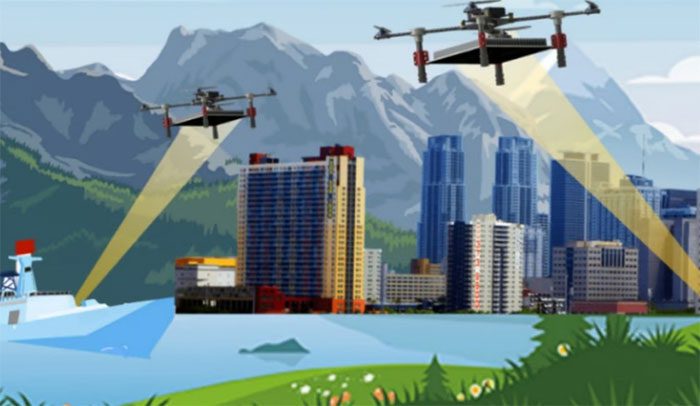A group of Chinese researchers has announced a novel approach to utilizing high-energy laser beams, not to destroy UAVs (Unmanned Aerial Vehicles), but to keep them airborne for extended periods.
According to the South China Morning Post (SCMP), many countries are developing ultra-powerful laser systems to serve as weapons against drones. However, Professor Li Xuelong and his colleagues at Northwestern Polytechnical University (NPU) have taken a different approach to the relationship between lasers and UAVs.
They propose that if UAVs are equipped with a photovoltaic module to convert light energy into electrical energy, then high-energy laser beams could not only track them but also provide power remotely.

Illustration of an Optically Controlled UAV (ODD) in use. (Photo: Northwestern Polytechnical University)
The research team reported that a recent experiment successfully integrated an automatic charging process with intelligent signal processing and transmission technology. This experiment demonstrated the potential for unlimited flight time of Optically Controlled UAVs (ODD).
The team shared via NPU’s official WeChat account last week: “A key highlight of the research is the 24-hour intelligent visual tracking system and automated long-range energy supplementation for ODD.”
According to the researchers, the first challenge is tracking the UAVs in the air. The team developed an image-based tracking algorithm that accurately follows and predicts the trajectory of ODD targets as they fly.
The report indicated that the algorithm performed robustly across various environments, pinpointing the exact location of the UAVs.
To extend the range of wireless energy transmission, Professor Li and his team needed to address the issue of laser beams typically losing strength in the atmosphere. They proposed a solution involving adaptive beam shaping technology, which can automatically adjust intensity.
Reportedly, this adjustment means mitigating the negative effects of atmospheric turbulence and density variations, thus enhancing the effectiveness and reliability of long-distance laser power delivery.
An additional protective algorithm was incorporated into the system, automatically adjusting the laser power to safe levels upon detecting obstacles in the beam’s path.
The research team did not disclose specifics regarding the operational range and photovoltaic conversion efficiency of the system due to the sensitivity of the technology, which holds potential military applications.
An animated illustration in the report depicted the ODD capable of flying to the height of a skyscraper.
The research team stated that they conducted three field tests: indoor flight, outdoor daytime flight, and outdoor nighttime flight. The UAV operated successfully in all scenarios.
UAVs are widely used in military, agricultural, and commercial sectors, but overcoming flight time limitations could unlock new possibilities for the world.
The report noted: “In some time-sensitive missions, such as searching for tourists stranded in flash floods, continuous flight of UAVs would significantly reduce valuable rescue time. ODD will play a crucial role in social governance, such as traffic control, security patrols, disaster rescue, and contactless logistics. In the future, larger UAVs could transform into aerial buses, establishing a three-dimensional transportation network. We might even create a ‘low-orbit satellite’ or ‘artificial moon’ using this technology.”
Some analysts believe that in a military context, automated ground-to-air wireless energy charging could enhance the advantages and effectiveness of UAV swarms, such as the “swarm” UAV coordination system unveiled by the China Electronics Technology Group in September 2020.


















































